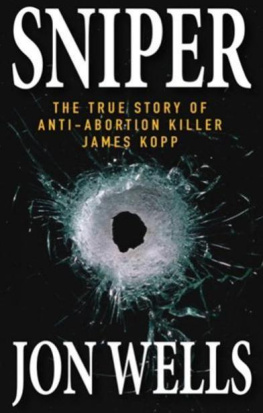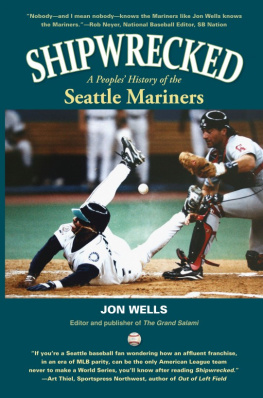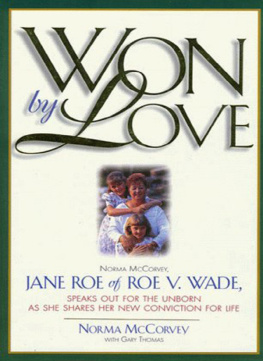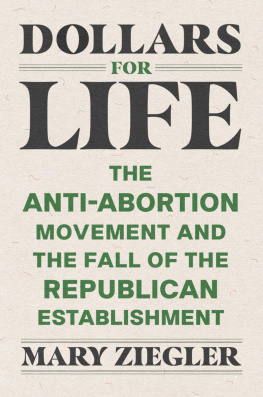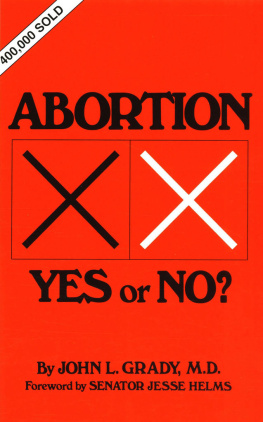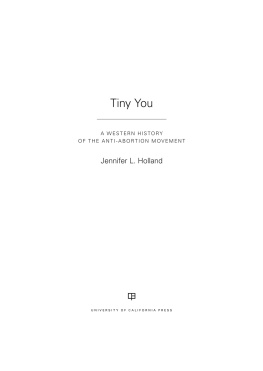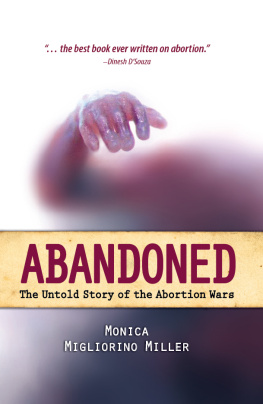SNIPER
Also by Jon Wells
Heat: A Firefighters Story (James Lorimer & Company)
SNIPER
THE TRUE STORY OF ANTI-ABORTION KILLER JAMES KOPP
JON WELLS
Copyright 2008 by Jon Wells
All rights reserved. No part of this work covered by the copyright herein may be reproduced or used in any form or by any meansgraphic, electronic or mechanical without the prior written permission of the publisher. Any request for photocopying, recording, taping or information storage and retrieval systems of any part of this book shall be directed in writing to The Canadian Copyright Licensing Agency (Access Copyright). For an Access Copyright license, visit www.accesscopyright.ca or call toll free 1-800-893-5777.
Care has been taken to trace ownership of copyright material contained in this book. The publisher will gladly receive any information that will enable them to rectify any reference or credit line in subsequent editions.
Sniper was first published in serial form in 2004 in The Hamilton Spectator.
Library and Archives Canada Cataloguing in Publication Data
Wells, Jon
Sniper : the true story of anti-abortion killer James Kopp / Jon Wells.
ISBN 978-0-470-15546-2
1. Kopp, James, 1954 2. Slepian, Barnett, 1946-1998. 3. MurderNew York (State)Amherst. 4. AbortionUnited States. 5. Pro-life movementUnited States. 6. MurderersUnited StatesBiography. I. Title.
HV6248.K66W44 2008 364.1523092 C2008-900604-6
Production Credits
Cover design: Ian Koo
Interior text design: Mike Chan
Typesetting: Mike Chan and Tegan Wallace Cover Photo: Don Farrall/Photodisc/Getty Images Printer: Quebecor World-Fairfield
John Wiley & Sons Canada, Ltd. 6045 Freemont Blvd.
Mississauga, Ontario
L5R 4J3
Printed in the United States
1 2 3 4 5 QW 12 11 10 09 08
To Dana Robbins,
with gratitude for his encouragement, guidance and friendship
Table of Contents
Acknowledgments
I want to thank Dana Robbins and Roger Gillespie for their support and suggestions when I worked on the original Sniper story for the Hamilton Spectator; also lead editor Dan Kislenko, and Douglas Haggo. Special thanks to Scott Gardner who photographed the story and was an indispensable colleague and friend on the road. I thank Kirk LaPointe for giving me my first big career break and my first crack at long-form journalism.
I appreciate the support of the book undertaking from current Spectator editor-in-chief David Estok, publisher Ian Oliver, and especially managing editor Jim Poling, who stickhandled the contract. Thanks to Carmelina Prete, Pete Reintjes, and Scott Petepiece for suggestions and feedback. And of course I thank the people at John Wiley & Sons.
Most of all, I note the contributions of those who provided information that helped me craft the story. Chief among these were the Hamilton detectives who investigated the sniper attack on Dr. Hugh Short and who are referenced in the piece. The case, like all of the attacks, is a disturbing one. I thank them for their participation and candor. I also want to single out assistance from FBI profiler James Fitzgerald at the Behavioral Analysis Unit in Quantico, Virginia, and special agents Bernie Tolbert and Michael Osborn. Finally, I take advantage of this opportunity to thank my family for their love and inspiration. You mean everything.
Jon Wells Hamilton, Ontario
Introduction
Dark, early evening in Dublin. Wet cobblestone glistens under streetlights, a damp, bracing nip in the air. The writer checked his watch. Six oclock. It had been 72 hours since he met the sniper for the first time, back in the United States. James Charles Kopp. What wasthe weather like, this morning, where you live? was the first thing Kopp had said, quietly, deliberately, as though expecting some kind of code phrase in reply. And now, across the Atlantic, the writer ducked into a crowded Dublin cybercafe and checked email. Finally, the message was in. Subject: From Jim.
That was how I led the opening chapter of an early draft of Sniper. I showed it to my editor Roger Gillespie and he asked why was I inserting myself into the story? I got the message, and Roger was correct, as usual. The true story of anti-abortion doctor killer James Kopp ran every day in the Hamilton Spectator over the course of seven weeks in 2004. I have now polished, updated and edited the narrative for this book. Looking back, my writer-in-Dublin theme no doubt reflected my fascination as I chased Kopps shadow far and wide. Research over a tenmonth period took me from crime scenes in Hamilton, Ontario, Winnipeg, Vancouver, and Amherst, New York, to New York City, San Francisco, Ireland and France.
Sniper s length and narrative voice were, and remain, unusual in the world of print journalism, but it was not my first project of that naturethat was Poison, a series which won a National Newspaper Award in Canada. I note that while Poison, Sniper, and my other serials to date are written in a novelistic style, all of the detail, dialogue, and thoughts of the characters are true, based entirely on reportage.
In order to craft the story of James Kopps life and crimes I interviewed nearly 100 people, ranging from those he went to high school with, to prosecutors and defense lawyers at home and abroad, more than a dozen law enforcement officers ranging from FBI agents to city detectives, and individuals on the radical fringe of the anti-abortion movement. I studied hundreds of pages of 2 Jon Wells
court transcripts and FBI search warrant documentsand loaded and fired an SKS assault rifle at a shooting range. In large measure what made Sniper such a compelling and at times disturbing creative journey for me was the access I gained to James Charles Kopp. To my knowledge, while the paranoid Kopp has been sought by print and TV journalists in Canada and the United States over the years, he has never engaged in any in-depth contact with any of them. As it happened, I was able to exchange many letters with him and meet for several hours of face-to-face interviews. This access allowed me to better retrace his early life in the San Francisco area, and his steps while on the lam from police and the FBI overseas. It also provided opportunity to get inside his head, understand the way he talked and thought. Immersing myself in his world was at times difficult to take, but it did help me write Sniper with more authority and color than otherwise would have been possible. I have told this story using different voicesKopps most notably, but also those of law enforcement and anti-abortion activists all along the spectrum. A note to the reader: I dont always telegraph when the voice changes, and the language used when visiting the fringe of the anti-abortion/pro-life movement is often quite graphic.
I have told colleagues the story of my unprecedented experience interviewing Kopp in person. He agreed to talk but also refused to let me record him or even take notes. It was no doubt his way of trying to provide deniability for whatever I would write. (I can hear him now: Jon Wells? Never heard of him. Knew a Wells in the Bay Area once but thats another story) When I left each of our interview sessions I immediately turned on my tape recorder and dictated. While Kopp rambled on many tangents, much of what he said stuck with meindeed, probably for longer than I would have liked. Eventually Kopp stopped contacting me altogether, just as he told me he would one day without warning, and just as he vowed to others he knew over the years. As the story illustrates, this was at his core. Unpredictability, deceptionwhat he called Romanitaeven towards his friends and family, was by his reckoning essential for everyones own good, and the good of a movement for which he ultimately deemed it a moral necessity to shoot doctors under cover of darkness.

